 |
New York
Architecture Images- Midtown Munson Diner moved 2005 |
|
architect |
Kullman Dining Car Company of New Jersey |
|
location |
11th Avenue & 49th Street |
|
date |
late 1940's |
|
style |
Art Moderne |
|
construction |
Stainless steel, glass This diner two section diner measures 25' x 50'. The the size of the dining car is approximately 16' wide and 50' long. The kitchen addition is 8.5' x 50'. The seating capacity of the diner is 43 with 7 booths and 15 stools. |
|
type |
Diner |
|
|
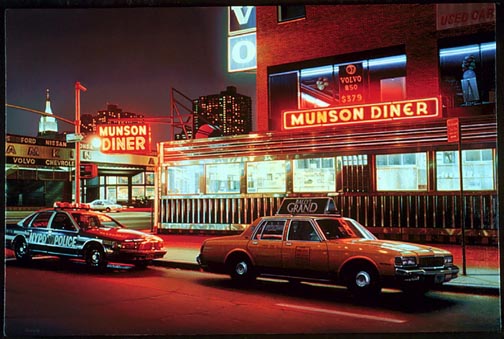 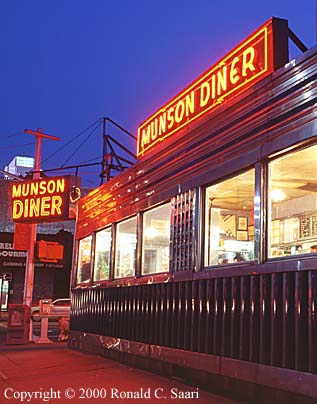 |
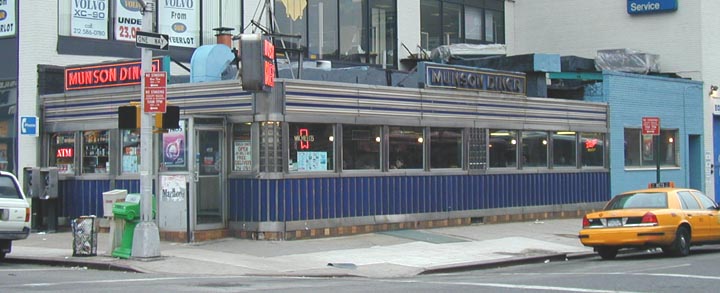 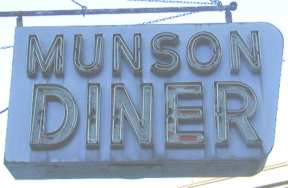 |
|
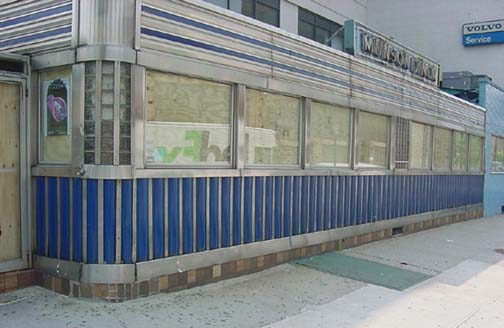 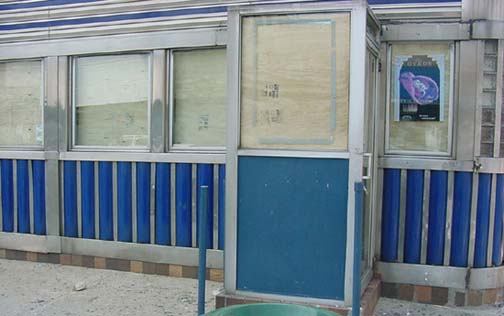 |
|
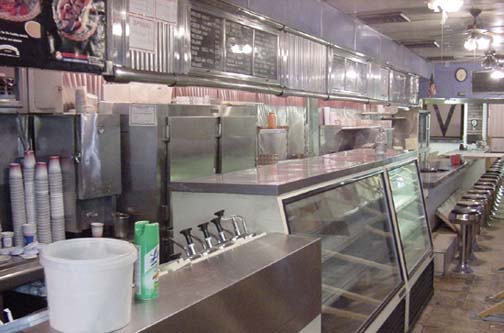 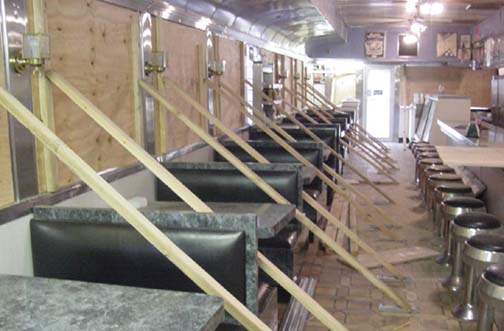 |
|
|
notes |
The Munson Diner is a Kullman from 1950. At one time, there were five or six Munson Diners in New York City, owned by the same family. As of August 2004, this diner was boarded up and has subsequently been moved. For more, see these websites: 1 and 2. www.roadsidenut.com |
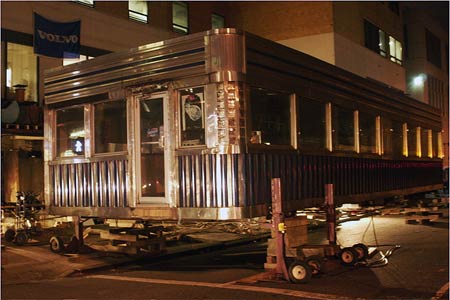
Being boarded up for months and months doesn't mean gone and forgotten: It turns out that old-school Hell's Kitchen culinary refuge, the Munson Diner, was headed up to the Catskills, where developers there wanted a "retro and classy" diner for the town of Liberty. The Volvo dealership that bought the Munson Diner plot at West 49th Street and 11th Avenue (so it could expand its showroom) decided to sell the diner and move the diner for $250,000 even though it was a "losing" financial proposition. Even though Gothamist wants to "hrmphh!", Volvo did do the right thing, or else there would be preservationists picketing them; now the preservationists - and others - are thrilled that this piece of NYC history will still be alive. WhatISee has some nice photos of construction workers preparing the diner for the move. Gothamist can't wait for photobloggers in the Catskills to blog its arrival. And here's Forgotten NY's page about NYC diners. Photograph by WhatISee |
|
|
STREETSCAPES/49th Street and 11th Avenue;
For Sale: 1945 Diner; $33,500, Nostalgia Included By CHRISTOPHER GRAY Published: November 21, 2004, Sunday LOOKING for that unique Christmas gift? Don't search those expensive shops on Fifth Avenue. Instead, go over to 49th Street and 11th Avenue, where you can get, for only $33,500, a jewel-like work of art in stainless steel. Make certain it fits, because it's definitely not returnable. Gift wrapping and shipping may be a problem, too -- because you will be buying the Munson Diner, built in 1945 and available to anyone with a flatbed truck. According to an expert on American diners, Richard J. S. Gutman, the evolution of the diner can be traced to 1872, when a horse-drawn wagon began serving inexpensive food to night-shift workers at The Providence Journal. In his book ''American Diner Then and Now'' (Johns Hopkins University Press, 2000), Mr. Gutman writes that in 1898, a survey of eight such wagons in New York City indicated that they were serving 230,000 meals a year. In 1922, The New York Times reported ''a renaissance of the lunch wagon today.'' It added that ''there's something fascinating about a lunch wagon.'' At that time, Harry Hack, who operated a lunch wagon on Union Square, said that New Yorkers liked diners because ''you see the stuff coming out of the icebox and you know what you're getting.'' The previous year, Samuel Zelin and a partner, Irving Greenman, rented space at 106 East 14th Street for the Munson Lunch Company, apparently a quick-lunch restaurant in an existing building. The 1930 census indicates that Zelin was born in Poland in 1893 and arrived in New York in 1907. In the 1910's, diners were built in the shells of old trolley cars, but by the 1920's they were being built by a dozen or more firms as turn-key operations for fixed sites. One builder was the Kullman Dining Car Company, founded in 1927 by Samuel Kullman, which soon produced hundreds of enameled metal-panel diners. But in 1941, an article in The Times praised a new development -- the fashion for streamlined stainless steel diners, ''as compact and neat as a bank's safe deposit vaults,'' where all classes of New Yorkers gathered on equal terms, especially as the nightclubs met the night shift: ''men and women in evening dress swap jokes with men in overalls.'' Zelin operated other restaurants, and the first identified diner he built was recorded with the Department of Buildings in 1942; it was in the old Union Freight Terminal, at Greenwich and West Houston Streets. In 1944, Zelin, operating as Delano Realty, acquired an existing old-style diner built in 1930 on the southwest corner of 49th and 11th. The next year, he built the Munson Diner on the corner -- a new Kullman model in streamlined stainless steel. Mr. Gutman says that there were 4,000 to 5,000 diners in the country in the 1940's, and that there are about 1,500 now. His book lists more than 60 diners still in operation in New York City. Many are from the 1970's and later, when Mediterranean styles in stone were popular, but some are from the stainless steel era, like the jet-age Market Diner at the northeast corner of 43rd Street and 11th Avenue, designed in 1962 by DeRaffele Diners. The Munson is a lovable work, with the hallmarks of the 1940's style: a base of vertical strips of stainless steel holding in bowed, bright blue enameled panels; glass-block infill at various points along the window level; and horizontal blue and stainless steel striping along the top. Its red neon lights cast a haunting, rosy glow on the street until they were turned off over the summer. In 1950, Manhattan Pontiac built a two-story buff brick building, designed by Horace Ginsbern, that wrapped around the Munson; it added two more floors in 1954. But who was Munson -- not to mention Zelin? Frances Zelin is the widow of Felix Zelin, who was the son of Samuel Zelin (the elder Zelin died in 1971). She tells the intricate saga of diners and the Zelin family -- or rather, the Zelin families. Mrs. Zelin says that her father-in-law, whose name was originally Zelinsky, and Greenman, his partner, ''were searching around for a name that didn't sound too ethnic'' and adopted the name of the Munson Steamship Company. Mrs. Zelin, who married Felix Zelin in 1946, recalled the process of choosing the styling of a Kullman diner. ''You tried to be a little original with the Formica finishes on the interior,'' she said. ''You could choose pearlized gray, dusty rose or dull blue.'' She discovered that the diner business was grinding. ''When my husband and I were dating, he said, 'While you're sleeping you're making money,' but after we were married we got calls in the middle of the night about things that had broken down, the cash register, the dishwasher,'' she said. The Zelins gradually added more diners, and by 1959 they had at least five, including four on 11th Avenue -- at 24th, 37th, 42nd and 49th. Samuel also had several brothers who operated a parallel diner business, including the Market Diner. The competition was friendly, Mrs. Zelin said. The family of Irving Greenman -- his sister Fay married Samuel Zelin -- also built several diners, including the Empire Diner at 22nd Street and 10th Avenue. Mrs. Zelin's son Gerald said that the family ''lived and breathed diners.'' ''When we'd meet we'd just talk about diners,'' he said. ''When we went on a vacation we ate in diners; my father didn't eat in French restaurants, because he always felt that if you couldn't see it cooking, they were hiding something from you.'' He said he had worked in one of the family's diners ''for many, many summers -- the doughnut oil is still in my blood.'' The family sold the 49th Street diner around 1980. Martin Motor Sales, which owns the old Pontiac Property surrounding the diner, bought the Munson and the land underneath it for about $3.5 million in August, according to the Web site www.propertyshark.com. Anthony Chianese, the general manager for Martin, said that his company is planning an expansion and planned to demolish the diner. But ''we had people approach us as soon as the boarding went up on the windows,'' he said, and the American Diner Museum now has it listed for sale for $33,500 on its Web site, www.DinerMuseum.org. Mr. Gutman said that the Munson had almost been certainly delivered in one piece on a flatbed truck in the 1940's, and that it could be removed that way, as many other diners have. It could even be lifted to the top of any new building Martin may erect. The American Diner Museum has nearly 20 diners for sale on its Web site, from less than $10,000 to more than $100,000. Most have previously been relocated, or must be moved upon sale. Mr. Chianese said that Martin Motor Sales has a couple of possible buyers and needs to move the diner fairly soon -- indeed, by Christmas. Published: 11 - 21 - 2004 , Late Edition - Final , Section 11 , Column 4 , Page 8 Copyright New York Times. |
|
|
More info American Diner Museum (401) 723-4342 or email your inquiry to dinerforsale@americandinermuseum.org |
|